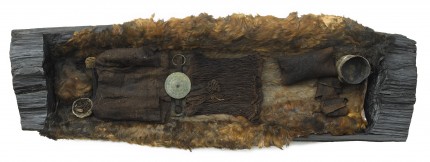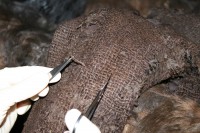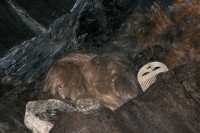
Egtved Girl, the Bronze Age woman whose exceptionally well-preserved grave was discovered near the village of Egtved on the Jutland peninsula of southeastern Denmark, was not born in Denmark. Researchers from the National Museum of Denmark and the University of Copenhagen studied the remains of her body, clothes and accessories using a combination of biomolecular, biochemical and geochemical techniques to determine not just where she was born and raised, but also to trace her movements in the years before her death and burial. Read the full study here.
The grave of Egtved Girl was excavated from the eastern side of the Storehøj barrow in 1921. She had been put to rest in a hollowed out oak trunk lined with cow hide and grave goods placed inside with her. Next to her head was a box made of bark containing a bronze awl and a hair net. At her feet was a birch bucket with a brown residue composed of ingredients like bog cranberries, wheat and lime tree pollen that were used to make a kind of mead. She wore bronze arm rings on each arm, an earring in one ear and a bronze belt plate of impressive size. A horn comb was attached to her belt. Her clothing was a short woven tunic and a cord skirt 15 inches long wound twice around her waist. both made of wool.
Although so many organic materials survived her long slumber, most of her own tissues decayed. Only her blonde hair, teeth, nails, and a small amount of skin and brain remained. Her bones probably dissolved in the acidic environment inside the coffin. A bundle of cloth was found to containing the cremated remains of a child 5-6 years old. A few charred bone fragments from the child were found in the bark box near her head. Egtved Girl was probably not her mother as her teeth indicate she was just 16-18 at the time of death. Dendrochronological analysis of the coffin dated the burial to 1,370 B.C.
For so young a woman to have such a high status burial is very rare. She must have held an important position in society, possibly a priestess or a ritual dancer. You might think, therefore, that she was local. To pinpoint her origins, the multi-disciplinary study used strontium isotope analysis of her first molar. They also tested the strontium isotope signature of the occipital bone of the child buried with her. The results were statistically indistinguishable, so the girl and the child came from the same place. Comparison to the Danish baseline and the specific strontium isotope values of the Egtved burial site excluded Denmark as their likely place of origin.
 Her clothes weren’t local either. Strontium isotope analysis found only a single wool cord in the container with the child’s cremated remains that was of Danish origin. The rest of the wool fibers tested, all of them very high quality, had varied strontium isotope values that indicate the sheep grazed in an area with a widely varied ecology. The possible range for the origin of Egtved Girl, the child she was buried with and her garments stretches from southern Scandinavia to southern Germany, but researchers believe she was from the Black Forest which has a variety of strontium isotope values commensurate with those in the wool fibers.
Her clothes weren’t local either. Strontium isotope analysis found only a single wool cord in the container with the child’s cremated remains that was of Danish origin. The rest of the wool fibers tested, all of them very high quality, had varied strontium isotope values that indicate the sheep grazed in an area with a widely varied ecology. The possible range for the origin of Egtved Girl, the child she was buried with and her garments stretches from southern Scandinavia to southern Germany, but researchers believe she was from the Black Forest which has a variety of strontium isotope values commensurate with those in the wool fibers.
“In Bronze Age Western Europe, Southern Germany and Denmark were the two dominant centres of power, very similar to kingdoms. We find many direct connections between the two in the archaeological evidence, and my guess is that the Egtved Girl was a Southern German girl who was given in marriage to a man in Jutland so as to forge an alliance between two powerful families,” [University of Gothenburg professor] Kristian Kristiansen says.
According to him, Denmark was rich in amber and traded amber for bronze. In Mycenaean Greece and in the Middle East, Baltic amber was as coveted as gold, and, through middlemen in Southern Germany, large quantities of amber were transported to the Mediterranean, and large quantities of bronze came to Denmark as payment. In the Bronze Age, bronze was as valuable a raw material as oil is today so Denmark became one of the richest areas of Northern Europe.
“Amber was the engine of Bronze Age economy, and in order to keep the trade routes going, powerful families would forge alliances by giving their daughters in marriage to each other and letting their sons be raised by each other as a kind of security,” Kristian Kristiansen says.
 To determine her travels in the two years before her death, the research team used her nine-inch-long hair. The strontium signature indicates she that 13-15 months before she died, she was somewhere with very similar strontium values to the place she was born. Then she moved probably to Jutland where she stayed for about 9 or ten months before going back home for four to six months. Her last trip was to Egtved about a month before her death. This is the first time researchers have been able to trace the movements of a prehistoric person with such precision.
To determine her travels in the two years before her death, the research team used her nine-inch-long hair. The strontium signature indicates she that 13-15 months before she died, she was somewhere with very similar strontium values to the place she was born. Then she moved probably to Jutland where she stayed for about 9 or ten months before going back home for four to six months. Her last trip was to Egtved about a month before her death. This is the first time researchers have been able to trace the movements of a prehistoric person with such precision.
Our study provides evidence for long-distance and periodically rapid mobility. Our findings compel us to rethink European Bronze Age mobility as highly dynamic, where individuals moved quickly, over long distances in relatively brief periods of time.